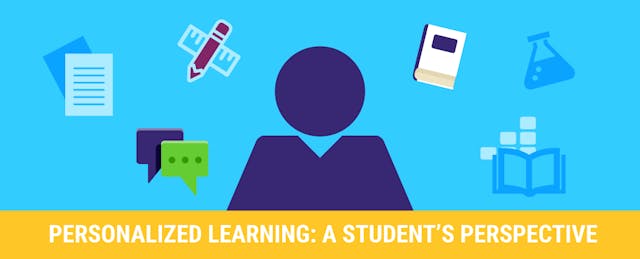Alex, 17, and Nicholas, 14, are brothers who attend Innovations Early College High School, a student-centered, personalized education school that is part of the Salt Lake City School District. It’s a very different place from a traditional high school. There is no standard bell schedule; instead, students can choose which of their classes they want to work on throughout the day, and when.
While it’s gaining popularity, there is still plenty of confusion among educators about what personalized learning looks like and how it works; there are numerous ways to implement it. Innovations High follows a flex model of blended learning; students complete most of their coursework online at their own pace, under the guidance of a classroom teacher. They also pursue offline projects and activities.
A glimpse at a typical school day for Alex and Nicholas demonstrates one approach to personalized learning that’s already meeting with success, and offers lessons for school leaders considering making a switch to a more personalized curriculum.
When Alex and Nicholas arrive at school at 7 a.m., they choose which subjects they’d like to work on that day. Alex says he makes this decision by asking himself, “What do I want to learn about today? Is there anything I said that I’d finish soon?” He says he “greatly enjoys” the freedom to determine his own schedule each day. “This way, I can maintain focus on a particular subject until I’m finished, allowing me to work at blinding speed.”
Shortly after Alex and Nicholas get to school each morning, there is a bus available to take students to one of the district’s other high schools. There, they can participate in band, or take a class that is not offered at Innovations High, before again returning to their school by bus.
If the boys need help in a particular subject, they can meet with their teachers one-on-one or in a small group setting to go over a concept or receive additional support. If they are ready to take a test, they do so under the supervision of the teacher for that course. Although they use their own laptops, there is an option to use school-issued devices.
At Innovations High, students have mentors who closely follow their progress to make sure they are on a path to graduation. Before the school year began, Alex and Nicholas met with their mentors to choose classes based on their interests and graduation requirements. Students continue to see their mentors at least once a week, going over their progress and making sure they are on the right track for success. The mentors also email the boys’ mother, Brooke, several times a week to make sure she knows what assignments are due and can support their learning from home.
To complete their assignments, Alex and Nicholas log on to the school’s personalized learning management system, where they can view their objectives or work through the material that is assigned to them. They also have access to their own performance data, so they can track their progress toward their individual learning goals. This helps give them ownership of their learning and makes them more responsible for their own success.
“I love the fact that they are more independent,” says Brooke. “They are finding out what real adult life will be like.”
Both Alex and Nicholas say they love personalized learning and would not want to return to a more traditional school structure. Here are four key lessons that school leaders can learn from their experience.
Students’ personalities play a role in their success.
“Alex is self-motivated, and this model works well for him because he is very driven and knows what he wants to accomplish,” says his mother, Brooke. In fact, he is on track to graduate in December, a semester early, because he was able to work ahead at his own pace; he will enter college having already earned some credits. His brother, however, has at times struggled with the personalized learning approach. Says Brooke, “Nicholas needs more structure.”
Having the proper student support systems in place is critical.
Having a mentor who is co-responsible for the students’ progress “has really helped,” Brooke explains. For instance, the mentor has pushed Nicholas when he has needed it and has helped him to prioritize his assignments.
Increased freedom and choice can be a big change for students; allowing them to ease into this transition can help.
“For the first few days I wandered the halls, wondering what classroom I should go in,” Nicholas said. “I wasn’t ready to change from a set schedule to complete freedom.” He says he might have been better served initially if there were some sort of transitional structure in place to help.
“They should have taken it slow, at first having a set schedule and then slowly disintegrating it,” he recommends.
There is no single correct way to implement personalized learning—but you must have support from the whole school community.
Personalized learning “is not a drop-in, all-in-one toolkit,” offers Alex. “It must be supported by the administrators, the teachers, and the students; otherwise there will be no improvement.”
Alex suggests that school leaders “find a couple of scholarly students, as well as the more socially connected students. Put them all together and work on a plan that fits with the academic and social interests of the school. Remember, though: Every single person in the school must understand how your personalized learning system works—otherwise it will fail.”



